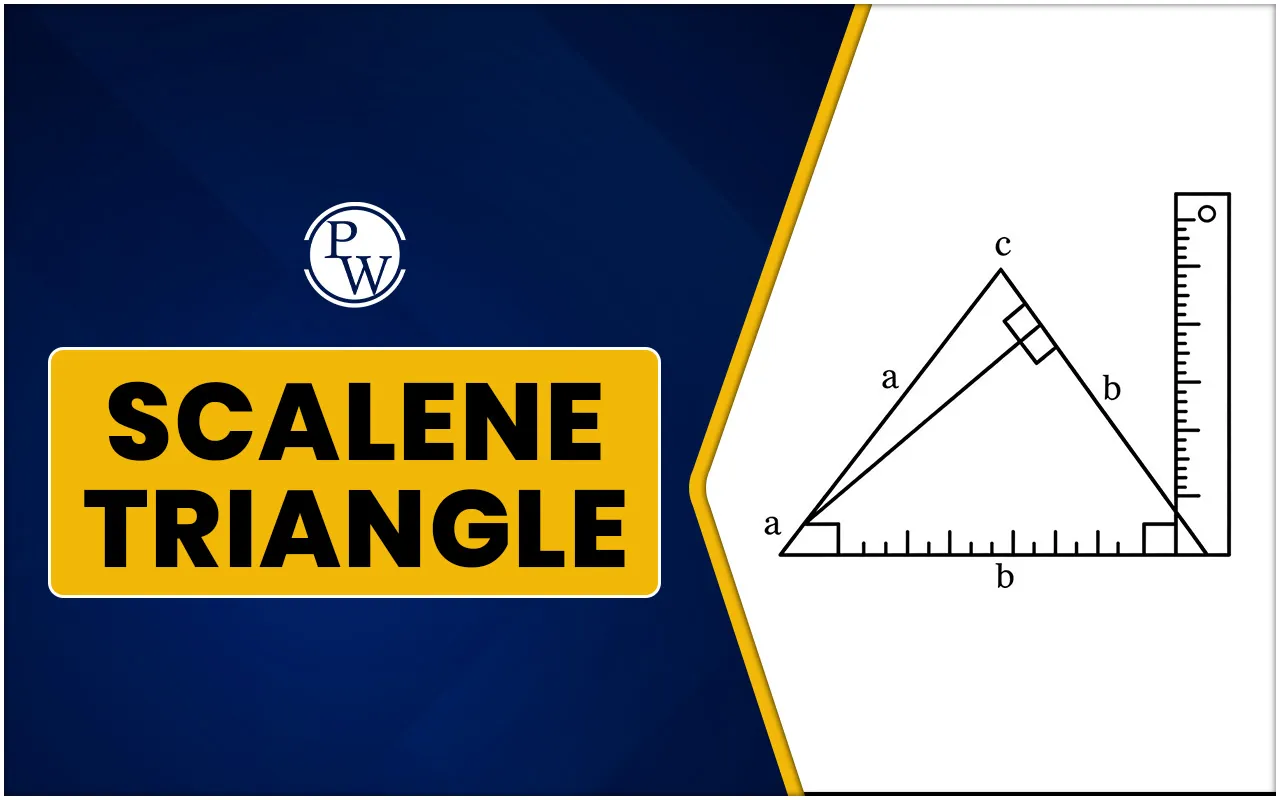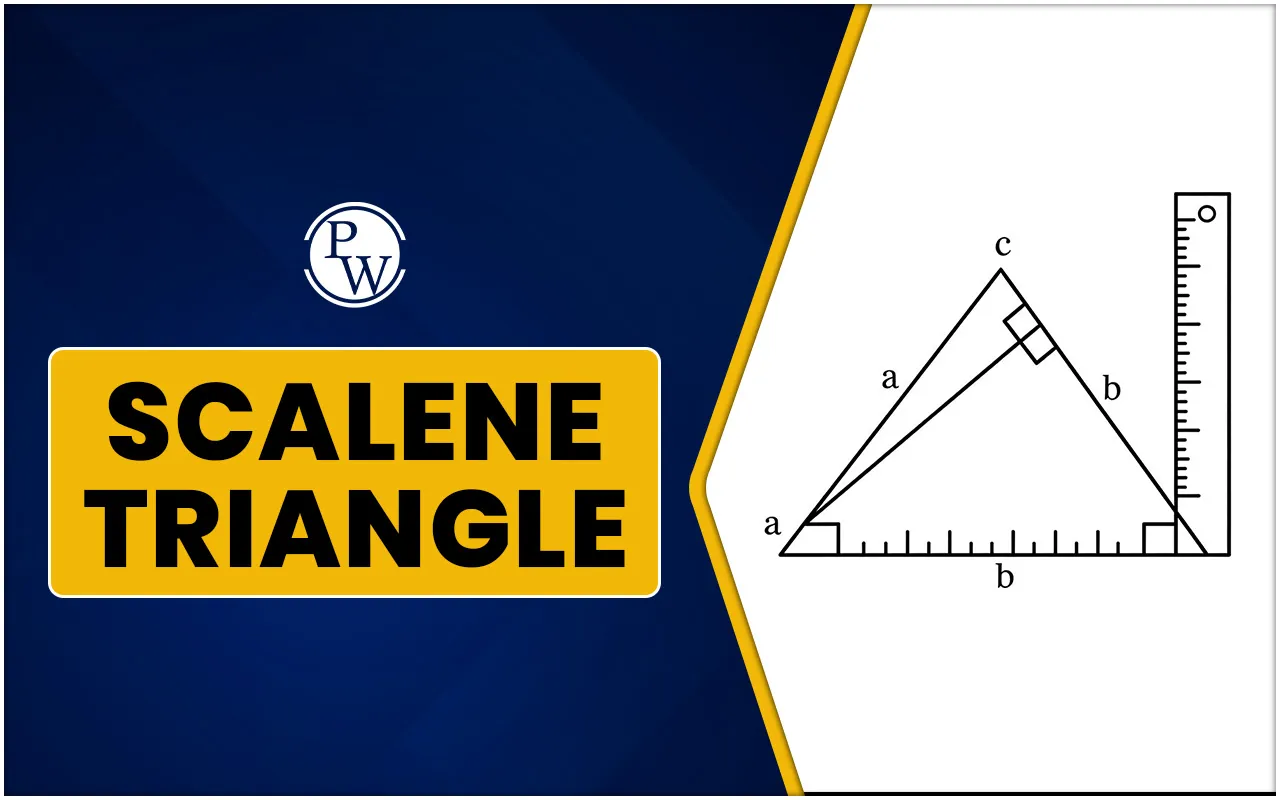

Scalene Triangle: While learning triangles in math, many children often ask, "What is a scalene triangle?" In geometry, triangles are divided based on the length of their sides. One such type is the scalene triangle. In this triangle, all three sides are of different lengths.
Hence, the scalene triangle definition in simple words is: "If a triangle has no equal sides and no equal angles, it is called a scalene triangle." While learning geometry in math, students can easily understand the scalene triangle meaning by checking whether all sides and angles are unequal.
Read More: Top 10 Tricks to Master Mental Maths
Scalene Triangle meaning
Learn "what is scalene triangle", A triangle with three sides of different lengths and three angles of differing measurements is called a scalene triangle. A scalene triangle has unequal angles and lines of symmetry, in contrast to an equilateral or isosceles triangle. However, the total of all internal angles is always equal to 180°. Therefore, it satisfies the triangle's angle sum condition.
Definition of Scalene Triangle
Among the three types of triangles in geometry, a scalene triangle is a triangle where all three sides have different lengths, and all three angles are also different. Even though the sides and angles are not the same, the scalene triangle still follows an important rule in geometry. The sum of all three interior angles in a scalene triangle is always 180°. This follows the angle sum property of a triangle.
So, the scalene triangle definition is: A triangle that has all sides and all angles unequal is called a scalene triangle.
What are the Properties of Scalene Triangle?
The scalene triangle properties make it unique. In this type of triangle, all three sides have different lengths. Also, all three interior angles are different from each other. Here are some properties of scalene triangle given below:
-
The sum of these angles is always 180°, which is true for every triangle.
-
Because no sides are equal or parallel, a scalene triangle has no line of symmetry. This means it cannot be folded to match itself exactly on any side.
-
The properties of scalene triangle also include the variety in its angles. The angles can be all less than 90° (acute), or one angle can be greater than 90° (obtuse), or one angle can be exactly 90° (right angle).
-
So, a scalene triangle can be acute, obtuse, or right-angled depending on its angles.
Read More: Fun Math Activities for Kids to Develop Calculation Speed
How a Scalene Triangle is Different from Isosceles and Equilateral Triangles?
Triangles can be of three types based on their sides: equilateral, isosceles, and scalene.
-
An equilateral triangle has all three sides equal. Because of this, all its angles are also the same, each being 60 degrees.
-
An isosceles triangle has two sides that are equal. The angles opposite these two equal sides are also equal.
-
A scalene triangle is different because all three of its sides have different lengths. This means all the angles in a scalene triangle are also different.
So, the main difference is in the sides and angles: equilateral has all equal sides and angles, isosceles has two equal sides and two equal angles, while scalene has no equal sides and no equal angles.
Scalene Triangle Formula
There are two important formulas related to a scalene triangle: one for its perimeter and one for its area.
Perimeter of a Scalene Triangle
The perimeter is the total length around the triangle. To find it, add all three sides together.
So, Perimeter = a + b + c
Here, a, b, and c are the lengths of the three sides of the scalene triangle.
Area of a Scalene Triangle
To find the area, if the base and height are known, use this formula:
Area = ½ × base × height
Where the base is one side of the triangle and the height is the straight line from that base to the opposite corner.
If the height is not known but all three sides are, then use Heron's formula:
First, find the semi-perimeter (half of the perimeter):
s = (a + b + c) ÷ 2
Then, area = √[s × (s − a) × (s − b) × (s − c)]
This formula helps find the area using only the side lengths.
Read More: Quick Calculation Techniques for School Students
Types of Scalene Triangle
A scalene triangle can be of three types based on its angles:
-
Acute-angled scalene triangle: In this type, all three angles are less than 90 degrees. That means all the angles are sharp and small.
-
Obtuse-angled scalene triangle: In this one angle is bigger than 90 degrees but less than 180 degrees. The other two angles are smaller than 90 degrees.
-
Right-angled scalene triangle: This triangle has one angle exactly equal to 90 degrees. The other two angles are different and less than 90 degrees.
Read More: How to Prepare for Math Olympiads with Mental Maths
Practice Questions Using Scalene Triangle Formulas
Here are some practice questions based on Scalene Triangle formulas. These will help children understand how to find the area and perimeter using different methods like Heron’s formula and ½ × base × height.
Practice Question 1: Using the Perimeter Formula
Q.1. A triangle has sides of 8 cm, 13 cm, and 14 cm. What is the perimeter of a scalene triangle?
Solution: Perimeter = Sum of all three sides
= 8 + 13 + 14
= 35 cm
Ans. The perimeter of the scalene triangle is 35 cm.
Read More - Quadrilateral: Definition, Types, Properties, Examples
Practice Question 2: Using Area = ½ × base × height
Q.2. The base of a scalene triangle is 10 cm and its height is 6 cm. Find the area of the triangle.
Solution: Area = ½ × base × height
= ½ × 10 × 6
= 5 × 6
= 30 cm²
Ans. The area of the triangle is 30 square cm.
Practice Question 3: Using Heron’s Formula
Q.3. The sides of a triangle are 5 cm, 7 cm, and 10 cm. Find the area of the scalene triangle using Heron’s formula.
Solution:
Step 1: Find semi-perimeter (s).
s = (5 + 7 + 10) ÷ 2
s = 22 ÷ 2 = 11
Step 2: Use Heron’s formula:
Area = √[s(s − a)(s − b)(s − c)]
= √[11(11−5)(11−7)(11−10)]
= √[11 × 6 × 4 × 1]
= √[264]
≈ 16.25 cm² (rounded)
Ans. The area of the triangle is approximately 16.25 square cm.
Read More - Factorial: Meaning, Formula, Values for Numbers 1 to 10
Practice Question 4: Using Two Sides and an Included Angle
Q.4. A triangle has two sides measuring 9 cm and 12 cm, and the angle between them is 60°. Find the area of the triangle.
Solution:
Area = ½ × a × b × sin(angle)
= ½ × 9 × 12 × sin(60°)
We know sin(60°) = √3 / 2 ≈ 0.866.
Area = ½ × 9 × 12 × 0.866
= 54 × 0.866
≈ 46.76 cm²
Ans. The area of the scalene triangle is approximately 46.76 square cm.
Help your child improve quick thinking and problem-solving skills with CuriousJr's fun and engaging Online Maths Classes. Book a demo class today to boost their confidence in math!
Do you need help with your homework or preparing for exams?
Study without using the internet
Scalene Triangle FAQs
What is the scalene triangle meaning?
What are the main properties of scalene triangle?
Can a scalene triangle have a right angle?
If a triangle has side lengths of 4 cm, 6 cm, and 9 cm, what type of triangle is it?
How to find the area of a scalene triangle?













